The Golden Arrow Land Speed Record Car
Written by Frank Paine for our Autumn 2021 Newsletter
The Golden Arrow first came to my attention many years ago, when, as a youngster, I came across an incomplete set of very old playing cards for a game called ‘Speed’.
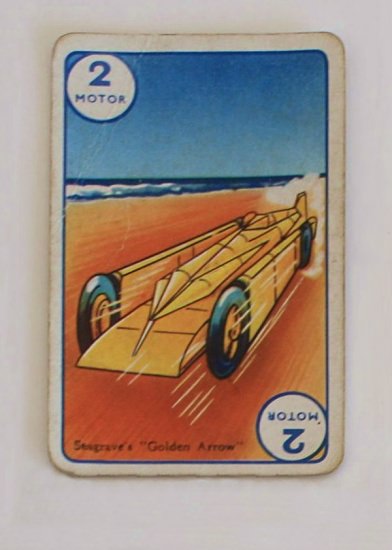
The Golden Arrow Speed card
All the cards had images representing speed of some kind, each with a number score against it. Some showed aeroplanes, others racehorses, express trains, ships, or racing cars, but what made most impression on me was one with a dramatic picture labelled ‘Golden Arrow’. This action-packed image of a strangely shaped car, with its three bulbous nacelles in the nose cowling and its side pods — unlike any car I had ever seen — has stayed with me ever since. There were no instructions showing how to play the game, but that didn’t matter. The images were fascinating enough.
Since that time relatively little literature, film or other coverage has featured the Golden Arrow car of the 1920s, presumably because its achievements were rather overshadowed by Malcolm Campbell’s several versions of Bluebird breaking a succession of pre-war land speed records. A few tinplate models — modern and vintage — of the sleek gold coloured car are extant, but information, even on the internet, is relatively limited.
My interest was rekindled some while ago by a chance find of an old National Motor Museum catalogue, showing a few images of the car, which is in their collection.
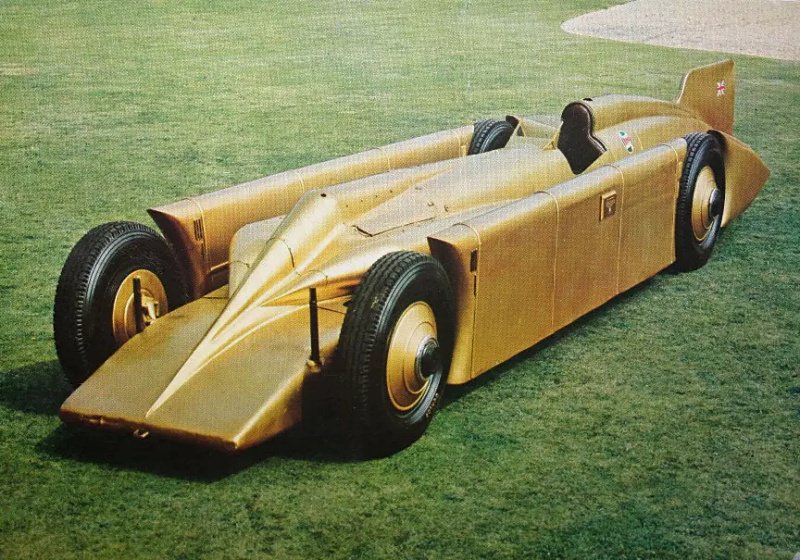
The Golden Arrow
I wondered whether, despite the apparently fiendishly difficult problem of representing — or even just suggesting — its unorthodox shape in Meccano, it would be possible to produce a passable version. I have never seen this attempted before, (which attracted me even more) and also the prospect of being able to reproduce the dramatic colour scheme in pre-war gold-painted Meccano strips seemed a worthwhile challenge. And a challenge it was, for, after several frustrating attempts and experiments with various shapes, the project was shelved. However, just after New Year 2021, during a period of ‘lockdown blues’, I decided to try again.
The ‘Irving-Napier Special’ Land Speed Record car, popularly dubbed ‘Golden Arrow’, was built in Britain in1928 for an attempt on the record in 1929 on Daytona Beach, Florida by Major Henry Segrave.
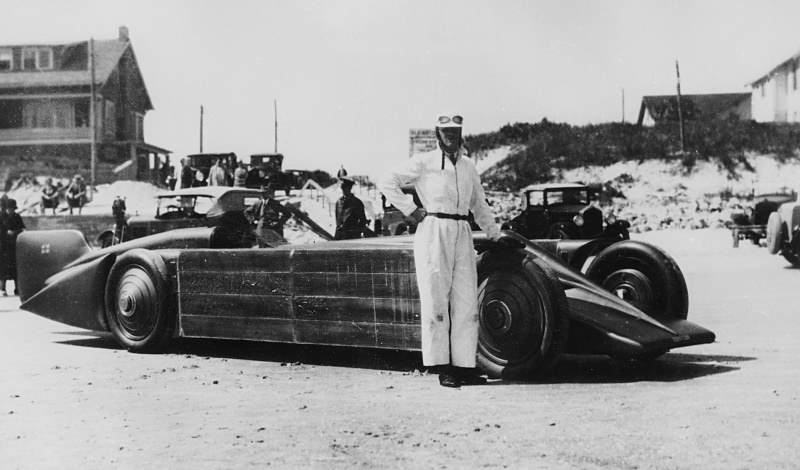
Henry Segrave pictured with Golden Arrow on Daytona Beach in 1929
It was powered by a 23.9 litre, 12 cylinder Napier ‘Lion’ aero engine, in ‘W’ (or ‘broad arrow’) configuration, i.e. with three banks of cylinders turning a single crankshaft (rather like modern Bentleys). This arrangement explains the presence of the three nacelles, or ‘power bulges’ at the nose of the car that project above the streamlined body. To help achieve a low profile, the engine powered the back wheels through two drive shafts, either side of the driver, in reinforced tunnels, in case of shaft breakage. There was no differential gear, presumably in the expectation (and hope!) that the car would essentially travel in a straight line, though there was a telescopic sight fitted so the driver could keep the car lined up towards its ‘target’. The side pods, which were for some time a bit of a mystery to me, were surface radiators with an ice (or chemical) cooling back-up facility.
In March 1929 Henry Segrave drove the car over the regulation two passes along the measured mile at an average speed of 231.45 mph, breaking the old record by 24 mph, watched by a huge crowd. The following day, another driver crashed his car on the course and was unfortunately killed, so the beach was closed by the authorities, and the Golden Arrow was never able to make another speed attempt. In fact, it has been estimated that the car has only ever travelled a total of 40 miles under its own power.
The Meccano model is approximately 1:15 scale and is 100% Meccano with no ‘foreign parts’. It is made almost entirely from gold painted strips from the 1934–41 Meccano blue and gold colour scheme. This means that the parts are about 85 years old — almost as old as the actual car. No parts have been cut or painted, though some bending of strips has been unavoidable — but it has been kept to a minimum as the gold paint finish is well known to be very fragile and easily damaged. Most gold painted strips found today have suffered from even moderate use. There are a few red parts from the same period, the steering wheel is from a Multikit set, and the headrest is a tyre from a modern pocket set. There are a few Aero collars and there is one Elektrikit part. The wheels, in order to replicate the original appearance, have gold discs from 1930s Meccano road wheels married to post-war black rims.
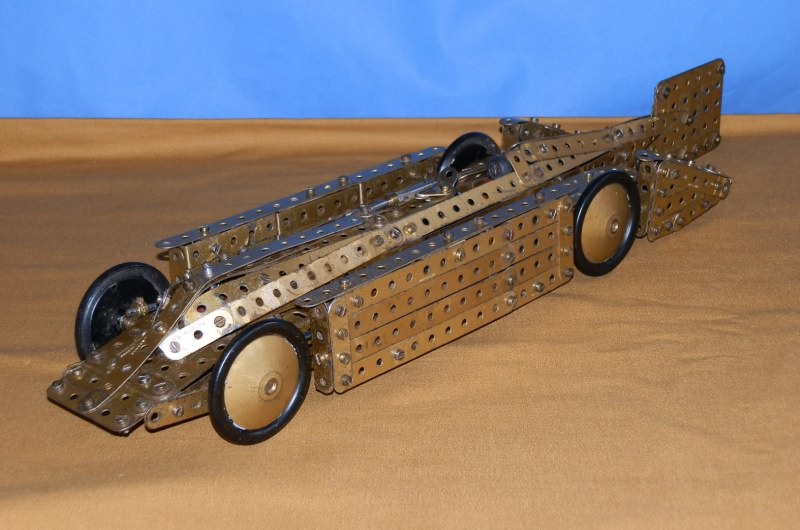
The model of the Golden Arrow
The model is essentially of simple construction, though a great number of fishplates and angle brackets — including obtuse ones — have been used to hold all the strips together, together with very many nuts and bolts, and access inside to connect the parts together has been problematic, partly because of the relatively small scale.
The dimensions and general shape have been taken from photographs of the original car and other limited available technical information, mainly on the internet, but some compromise, licence, and adjustment to cope with the limitations of Meccano parts has been inevitable, with perhaps a little leap of imagination needed on the part of the viewer. The sinuous unorthodox curves are arguably impossible to render precisely using strips, and a more accurate shape could possibly be achieved by the use of flexible plates, (perhaps with the help of tin snips!) especially at a much larger scale, but the impact of the original’s golden hue would then be lost without repainting. It is hoped that the general outline and spirit of the original has been achieved here, helped to a large degree, perhaps, by its dramatic colour scheme, to give a true impression of 1920s ‘speed’.
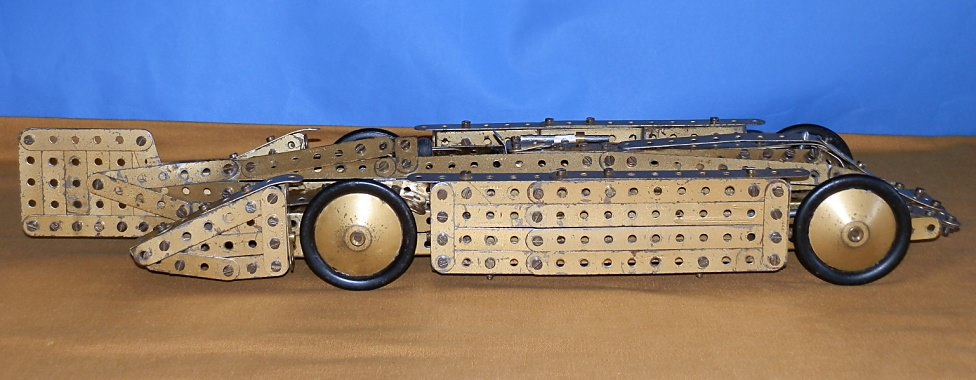
The model of the Golden Arrow
See more photos of this model.